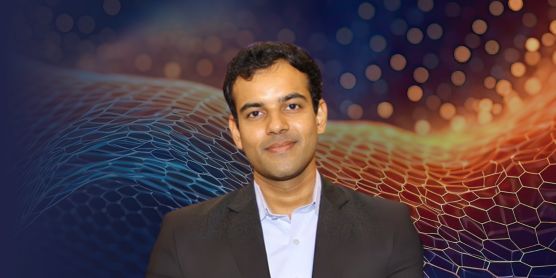Why attend
Global influencers shared powerful stories of how they confronted challenges – and learned from them

What Will You Gain?
Global influencers shared powerful stories of how they confronted challenges – and learned from them
IDC is the most trusted IT research advisory firm in the market
Access local IDC analysts across India and Asia/Pacific for region-specific insights
Engage with peers to address shared security challenges and exchange actionable strategies
An agenda crafted specifically for CISOs, CIOs, and security decision makers from leading enterprises
Learn through a powerful mix of analyst keynotes, expert case studies, and interactive discussions
Tailored IDC content ensures you gain practical insights, regardless of your security maturity
Explore emerging technologies, business models, and security investment strategies
This is an invitation-only forum that prioritizes meaningful connections and focused networking
Gated Assets

Analyst Spotlight Security and AI Investments: A Symbiotic Approach to Future-Proofing Organizations
In an era defined by rapid digital transformation and an ever-evolving threat landscape, organizations must rethink their approaches to security and innovation. The intersection of artificial intelligence (AI) and cybersecurity has emerged as a critical nexus for businesses aiming to protect their assets while enabling growth and resilience. By strategically combining investments in AI technologies with robust security frameworks, organizations can unlock new levels of efficiency, protection, and trust.
The global proliferation of digital technologies has expanded the attack surface for cybercriminals. AI-powered threats, such as social engineering campaigns leveraging deepfakes, are identified as critical concerns by 57.5% of organizations. Other high-risk AI-driven attack vectors follow closely, including AI-powered ransomware (53.8%), personalized social engineering attacks (51.3%), and AI-driven disinformation campaigns (45.0%), underscoring the growing sophistication of AI-enabled cyber threats.
According to IDC’s Asia/Pacific Security Survey, August 2024, 66% of organizations in India express low confidence in their ability to counteract AI-powered cyberattacks. This highlights the urgency for businesses to adopt equally advanced solutions to stay ahead of adversaries.
AI: The Game-Changer in Cybersecurity
AI has become a cornerstone in modern SOCs and transforming multiple facets of the security landscape:
1. Threat Detection and Response: AI algorithms can analyse vast amounts of data in real-time, identifying patterns and anomalies that may indicate a cyberattack. Predictive analytics powered by ML enables SOCs to detect threats before they cause significant damage.
2. Automation and Efficiency: Security automation tools, such as SOAR platforms, reduce the manual workload on IT teams. AI streamlines tasks like alert triage, incident response, and compliance reporting, improving overall operational efficiency.
3. Fraud Prevention: In sectors like fintech, AI-powered fraud detection systems analyse transaction patterns to predict and prevent fraudulent activities.
4. Behavioural Analytics: User and Entity Behaviour Analytics (UEBA) leverages AI to detect unusual behaviours, such as unauthorized access attempts or data exfiltration.
Strategic AI Investments for Enhanced Security
To fully leverage AI’s potential, organizations must make targeted investments in areas that yield the highest returns, such as
• Generative AI in SOCs: Gen AI tools can assist security analysts by generating reports, summarizing incidents, and recommending actions, thereby accelerating decision-making.
• AI-Driven Threat Intelligence Platforms: By aggregating threat data from multiple sources, AI enhances the accuracy and relevance of threat intelligence, empowering organizations to anticipate and neutralize attacks proactively.
• Predictive Analytics for Risk Management: AI models that predict vulnerabilities based on system configurations and user behaviours enable organizations to adopt a proactive stance toward risk mitigation.
• AI in Identity Management: Advanced authentication systems, such as biometric scans and adaptive access controls, utilize AI to ensure secure and seamless user experiences.
Sakshi Grover
IDC Asia/Pacific
Senior Research Manager, Cybersecurity Products and Services

CXO Spotlight Draft Telecom Cybersecurity Rules 2025 – Constitutional and Jurisprudential Implications
Analysis of the Draft Telecommunications (Telecom Cyber Security) Amendment Rules, 2025 correctly identifies this as a paradigm shift in India’s digital regulatory landscape. Building upon your observations, this comprehensive analysis examines the profound constitutional, legal, and practical implications of these transformative rules.
Executive Summary: The Regulatory Transformation
The Draft Rules represent the most significant expansion of state power in India’s digital communications sector since independence. By introducing Telecommunication Identifier User Entities (TIUEs) and the Mobile Number Validation (MNV) Platform, the government has fundamentally altered the regulatory ecosystem, bringing virtually all digital platforms under telecom cybersecurity oversight.
Deep Dive Analysis: Key Provisions and Legal Implications
1. TIUEs: Expanding the Regulatory Net
Constitutional Foundation and Challenges
The introduction of TIUEs represents a constitutional watershed moment. Under Article 19(1)(g) of the Indian Constitution, every citizen has the right to practice any profession or carry on any trade, business, or occupation. The Draft Rules now subject this fundamental right to mandatory telecom cybersecurity compliance for any entity using mobile numbers for user identification or service delivery.
Key Legal Implications:
·Definitional Breadth: The TIUE definition encompasses virtually every digital platform, from food delivery apps to healthcare platforms, raising questions about regulatory proportionality
·Compliance Burden: Unlike traditional telecom operators who chose regulatory oversight, TIUEs face involuntary regulatory subjugation simply by using mobile numbers
·Constitutional Test: The rules must satisfy the “reasonable restrictions” test under Article 19(6), requiring necessity, proportionality, and public interest justification
Sectoral Impact Analysis
The compliance burden varies dramatically across sectors, with fintech startups facing the highest impact (burden score 9/10) due to their extensive mobile number usage combined with limited compliance infrastructure. This creates a regulatory asymmetry that may stifle innovation in India’s burgeoning startup ecosystem.
2. MNV Platform: The Digital Identity Infrastructure
Technical Architecture and Legal Framework
The MNV Platform represents India’s attempt to create a unified digital identity verification backbone for the telecom sector. However, this raises fundamental questions about data sovereignty, privacy rights, and the state’s role in digital identity management.
DPDP Act Harmonization Challenges:
1. Data Minimization Conflict: The DPDP Act mandates collecting only necessary data, while MNV requires comprehensive validation data sharing
2. Purpose Limitation:DPDP restricts data use to stated purposes, but “cybersecurity” provides an expansive justification
3. Consent Paradox: DPDP emphasizes informed consent, while MNV operates on mandatory compliance principles
Constitutional Implications
The MNV Platform’s mandatory nature potentially violates several constitutional principles:
·Article 21 (Privacy Rights): Centralized data collection without adequate safeguards
·Article 14 (Equality): Differential treatment based on entity type (government vs. private)
·Article 19(1)(a): Potential chilling effect on anonymous communication
3. Emergency Powers Without Notice: The Due Process Dilemma
Supreme Court Precedent and Constitutional Standards
The provision allowing immediate suspension without prior noticedirectly contradicts the Supreme Court’s landmark judgment in Anuradha Bhasin v. Union of India (2020), which established that:
1. Proportionality Test: Any restriction must be proportionate to the threat
2. Temporal Limitations: Suspensions must be time-bound and reviewable
3. Published Orders: All suspension orders must be published for public scrutiny
4. Judicial Review: Courts must have oversight over suspension decisions
Constitutional Vulnerability: The Draft Rules’ emergency powers provision is constitutionally vulnerable to challenge on multiple grounds:
·Article 21: Violation of due process rights
·Article 19(1)(a): Unreasonable restrictions on free speech
·Article 19(1)(g): Arbitrary interference with business operations
Comparative Analysis with Global Standards
India’s 6-hour incident reporting requirement is more stringent than global standards (US: 72 hours, EU: 72 hours), raising questions about practical feasibility and proportionality.
4.IMEI Compliance: Closing the Security Loop
Legal Framework and Implementation Challenges
The enhanced IMEI compliance framework represents a comprehensive approach to device security, but raises several legal concerns:
Manufacturer Obligations:
·Extraterritorial Reach: Rules apply to foreign manufacturers, potentially creating jurisdictional conflicts
·Secondary Market Impact: Restrictions on second-hand device sales may violate Article 19(1)(g) rights of traders
·Data Retention: Indefinite storage of IMEI data raises DPDP Act compliance concerns
5.Fee Structure: Monetizing Security vs. Access Rights
Economic Impact and Constitutional Concerns
The tiered fee structure (₹0 for government, ₹1.50 for directed TIUEs, ₹3.00 for voluntary TIUEs) creates several legal challenges:
Constitutional Issues:
·Article 14 (Equality): Discriminatory pricing based on entity type
·Article 19(1)(g): Economic burden on business operations
·Access to Justice: High costs may exclude smaller entities from compliance
Economic Analysis: For a startup processing 1 million validations monthly, the ₹3 crore annual cost represents a significant barrier to entry, potentially violating constitutional principles of economic justice.
Jurisprudential Implications: The Legal Battleground Ahead
1. DPDP-Telecom Rules Harmonization
Regulatory Hierarchy and Conflict Resolution
The intersection of DPDP Act and Telecom Rules creates a complex legal hierarchy requiring judicial interpretation:
Potential Conflicts:
·Data Processing Grounds: DPDP requires specific grounds, while Telecom Rules invoke broad “cybersecurity” justification
·Consent vs. Mandate: DPDP emphasizes voluntary consent, Telecom Rules mandate compliance
·Cross-Border Data: DPDP restricts overseas transfers, MNV may require international validation
Likely Judicial Approach: Courts will likely apply the “harmonious construction” principle, seeking to balance privacy rights with national security imperatives while maintaining constitutional supremacy.
2. Constitutional Challenges: The Article 19 Battleground
Anticipated Litigation Patterns
Primary Constitutional Challenges:
1.Due Process Violations: Challenges to suspension without notice provisions
2. Proportionality Tests: Assessment of emergency powers against constitutional standards
3. Federal Structure: State vs. Central jurisdiction disputes over telecom regulation
Probable Supreme Court Approach: Based on recent jurisprudence, the Supreme Court will likely apply the “least restrictive means” test, requiring the government to demonstrate that less intrusive alternatives were considered and found inadequate.
3. Global Platform Applicability: Jurisdictional Complexities
International Law and Enforcement Challenges
Key Issues:
·Territorial Jurisdiction: Enforcement against foreign platforms operating in India
·Service of Process: Legal notice requirements for overseas entities
·Reciprocal Enforcement: International cooperation for compliance enforcement
Likely Legal Framework: Courts will probably adopt a “effects-based jurisdiction” approach, focusing on impact within Indian territory rather than corporate domicile.
Strategic Recommendations for Legal Compliance
1. Constitutional Safeguards Integration
Immediate Reforms Needed:
·Implement graduated response mechanisms before emergency suspensions
·Establish independent review boards for suspension decisions
·Create fast-track judicial review procedures for affected entities
2. DPDP Harmonization Framework
Recommended Approach:
·Develop sector-specific consent frameworks balancing security and privacy
·Create data minimization guidelines for cybersecurity purposes
·Establish cross-border data sharing protocols compliant with both regimes
3. Industry Support Mechanisms
Critical Requirements:
· Phased implementation timelines for different entity sizes
· Technical assistance programs for smaller TIUEs
· Cost-sharing mechanisms for compliance infrastructure
Conclusion: Navigating the New Legal Landscape
The Draft Telecom Cybersecurity Rules 2025 represent a fundamental recalibration of India’s digital governance framework. While the security objectives are laudable, the implementation approach raises significant constitutional, practical, and economic concerns.
Key Takeaways:
1. Constitutional Challenges: The rules face substantial constitutional vulnerabilities, particularly regarding due process and proportionality
2. DPDP Harmonization: Urgent need for coherent framework balancing privacy and security
3. Industry Impact: Disproportionate burden on startups and smaller entities requires targeted relief measures
4. Global Implications: International platforms will need India-specific compliance strategies
The Path Forward: Success will depend on the government’s willingness to address constitutional concerns, harmonize with existing privacy laws, and provide adequate support for industry compliance. The resulting jurisprudence will likely shape India’s digital governance framework for decades to come.
As cyberlaw practitioners, we must prepare for an extended period of legal uncertainty as courts, regulators, and industry stakeholders navigate this transformed landscape. The ultimate resolution will require judicial wisdom, regulatory pragmatism, and industry cooperation to balance India’s legitimate security concerns with constitutional rights and economic growth imperatives.
Gaurav Duggal
Jio Platforms Limited
SVP – AI & IT Security

Partner Spotlight Why India Must Prioritise Exposure Management Amid Rising Cyberattacks and AI-Driven Threats
Between May 7 and 10, 2025, over 650 cyber incidents were recorded in India. Hacktivist groups leveraged a blend of advanced malware and deceptive social engineering to infiltrate key Indian sectors such as government IT, healthcare and education. Such attacks on central and state governments can halt public services, compromise sensitive data and threaten public safety.
India is simultaneously making commendable digital investments across infrastructure, manufacturing and critical sectors. With the digital economy projected to contribute 20% to the GDP by 2026, the benefits of digital transformation are clear, but so are the risks. As digitisation accelerates, cyber threats are increasing in parallel. On average, India faces 702 potential security threats every minute, with healthcare emerging as the most vulnerable and frequently targeted.
Artificial Intelligence is Reshaping Cyber Threats
The growing use of artificial intelligence (AI) is also escalating the sophistication and scale of cyberattacks, complicating an already volatile threat landscape. AI enables attackers to rapidly identify, weaponise and exploit vulnerabilities and misconfigurations across multiple exposure points with unprecedented speed and precision. In this environment, traditional, reactive security models are no longer sufficient. India must shift to proactive cybersecurity frameworks that can match the speed and sophistication of AI-powered threats.
Why Exposure Management Platforms Are the Future of Cyber Defence
In today’s complex digital landscape, assets are sprawling across on-premises, cloud, operational technology (OT), and hybrid environments, often managed by disparate security tools. Exposure management cuts through this complexity, consolidating data from native and third-party solutions to eliminate blind spots and fragmented insights. This holistic perspective empowers security teams to move beyond isolated vulnerability scanning to truly understand how different exposures interrelate and contribute to overall business risk.
The platform’s key strategic benefit lies in its ability to connect the dots between various solution silos, revealing the “lethal relationships” that attackers exploit. Instead of merely listing vulnerabilities, exposure management provides contextualised risk insights, helping organisations prioritise the exposures that pose the greatest threat to critical business operations. This focus on business-aligned risk mitigation ensures that security efforts are not just technically sound but also strategically aligned with organisational goals, driving more efficient resource allocation and a clearer path to reducing overall cyber risk.
Furthermore, exposure management moves organisations from a reactive stance to a proactive one. By offering continuous visibility and actionable intelligence on exposure pathways, it enables security teams to anticipate and neutralise potential attack vectors before they can be exploited. This proactive approach is crucial in an era where the speed and sophistication of cyber threats are constantly escalating. The ability to rapidly identify, prioritise, and remediate the most critical exposures significantly enhances an organisation’s resilience against evolving cyberattacks, safeguarding valuable assets and maintaining operational continuity.
Strengthening Government Cybersecurity with Proactive Risk Management
Exposure management platforms help align with the government’s current priorities of securing digital infrastructure and promoting adherence to cybersecurity best practices and standards. By adopting an AI-driven exposure management platform, government systems can proactively know, expose and close critical vulnerabilities and cloud misconfigurations critical to the organisation. It enables continuous identification, prioritisation and remediation of cyber risk at scale. It does not evaluate risks in isolation. Rather, it understands how one weakness leads to another and how risk compounds across systems.
It helps security teams understand what matters most, how it could be exploited, and what needs to be prioritised to initiate remediation actions. This comprehensively protects critical digital assets, ensures regulatory compliance, and helps government organisations make bigger strides toward their broader digital vision.
Rajnish Gupta
Tenable India
Managing Director & Country Manager

Partner Spotlight Why SSL Decryption Can Backfire in DDoS Mitigation
Should we decrypt SSL/TLS traffic to detect malicious activity?.
While it might sound like a good idea, SSL decryption in DDoS mitigation often causes more harm than good. The trade-offs — from privacy concerns to performance slowdowns — can far outweigh any security benefit.
The Problem with SSL Decryption
SSL/TLS encryption protects sensitive data in transit, but it also hides malicious payloads. Attackers exploit this by launching SSL-based DDoS attacks that overload servers with encrypted requests, forcing resource-intensive decryption before traffic inspection.
Some providers propose decrypting traffic to detect threats, but this approach has serious drawbacks:
1. Privacy & Compliance Risks
Decrypting SSL traffic exposes sensitive user data — login credentials, financial information, personal records. This can:
• Violate privacy laws like GDPR, CCPA, and HIPAA
• Breach PCI-DSS requirements
• Damage customer trust if mishandled
2. Performance Slowdowns
Decryption is CPU-intensive. During a high-volume attack, this extra load can:
• Add latency and hurt user experience
• Reduce scalability when it’s needed most
• Impact service availability in critical moments.
3. Key Management Risks
To decrypt SSL, systems must access private keys or act as a man-in-the-middle using certificates. Both methods create:
• Complex key management challenges
• Serious security risks if keys are leaked or stolen
4. Limited Payoff
Even with decrypted data, sophisticated Layer 7 attacks can mimic legitimate traffic, making detection difficult. Attackers have learned how to blend in.
Better Alternativess
Modern DDoS mitigation doesn’t require breaking encryption. Instead, organizations can use:
• Behavioural Analysis: Monitoring traffic patterns and identifying anomalies without decrypting the data.
• Rate Limiting: Limiting the number of requests from a single source to prevent abuse.
• Signature Matching: Using pre-defined attack signatures to identify and block malicious traffic.
• AI/ML Usage: Advanced TCP Profiling for Progression Tracking, which learns progression tracking parameters from application traffic during ‘peace-time’ or normal traffic patterns. These auto-generated parameters provide countermeasures without requiring the intrinsic knowledge of the TCP application behaviour
The Takeaway
While SSL decryption might seem like a logical solution for addressing encrypted DDoS attacks, its drawbacks in terms of privacy, performance, and security often outweigh its benefits. Organizations should focus on deploying robust, non-intrusive mitigation strategies that respect user privacy and ensure compliance with regulatory standards.
By leveraging innovative approaches to traffic analysis and attack detection, organizations can effectively defend against DDoS attacks without compromising the trust and confidence of their users.
Tarun Verma
A10 Networks
Systems Engineer Manager

Partner Spotlight Multi-Agent Networks in AppSec: AI Collaboration at Scale
Application security has never been more critical for businesses, or more complex to execute well. As cloud-native architectures, open-source libraries, and LLMs reshape modern software development, security teams are struggling to keep up. Developers face long fix times. Security analysts drown in manual processes. CISOs can’t get clear answers on risk exposure or ROI.
This moment is when agentic AI, and, more specifically, multi-agent networks, change the AppSec game.
Unlike traditional generative AI, agentic AI systems don’t just suggest; they act to prevent and remediate vulnerabilities. Each agent is powered by a purpose-built large language model designed to reason, decide, and execute autonomously. When connected wihin a multi-agent network, these AI agents work together, collaborating with humans and each other to reduce friction, accelerate response times, and drive clarity across the SDLC.
That collaboration is critical. Developers need fast, reliable security feedback in their IDE or PR workflow. Security teams require intelligent automation to enforce policies and reduce alert fatigue. Executives need continuous visibility into application risk and progress. A multi-agent network meets each of these needs with role-specific agents that share context and align toward common goals.
The impact is real. According to the 2025 DevOps Evolution Report, over half of developers spend more than 21 hours per week on security tasks. Meanwhile, critical vulnerabilities often linger for more than 200 days. These aren’t just inefficiencies; they’re threats.
Agentic AI cuts through the noise. It reduces MTTR, improves DORA metrics, and frees engineering time by autonomously identifying and remediating vulnerabilities. It transforms AppSec into a shared, streamlined responsibility, embedding security deeply into development without slowing teams down.
This new generation of AppSec is not just automation. It’s collaboration at scale: AI agents working as an autonomous team to support developers, guide security, and inform leadership.
The future of AppSec isn’t a single assistant to check off security tasks, but rather intelligent AI agents working in sync to secure the software that runs your business.
Bhawani Singh
Checkmarx
Solutions Engineer Director, AMA
Stay tuned for exciting news!
Lorem ipsum dolor sit amet consectetur. Dui egestas in senectus suspendisse enim.Lorem ipsum dolor sit amet consectetur.
Register Now